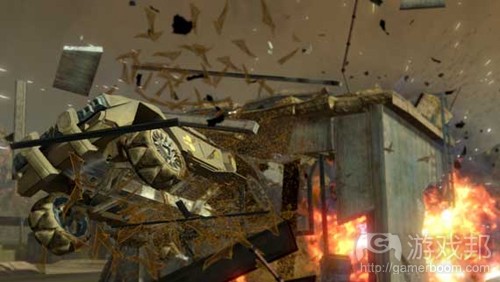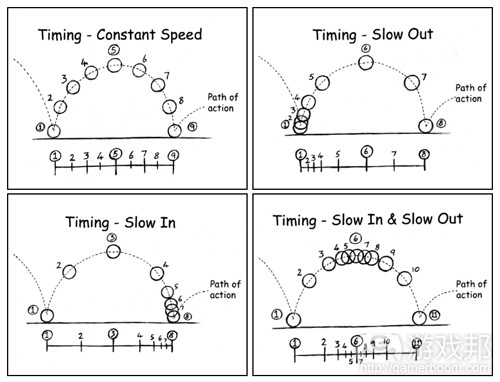以动画设计方式增加游戏设计筹码原则之三
作者:Michael Jungbluth
动作惯性跟随 & 动作重叠(Follow Through & Overlapping Action)
动画中的应用
无论你何时有动作,都必须能够过渡到下个动作,身体的不同部分在不同的时间移动和停止。通常情况下,这两个词语可以互换,但是二者之间还是存在细微的差别。动作惯性跟随的意思是,在物体停止之后,某个单独的部分还会继续移动。动作重叠指身体各部分的运动趋势,以及如何使用这种趋势从一个动作导向下一个动作。(请点击此处阅读本系列第1、第2、第4、第5、第6节内容)
我们先来阐述惯性跟随。以能量为例,它是无法停止的。它需要转化通过终点。正是这种惯性跟随通过身体和表现传达出重量感和连接性,同时向玩家展现动作的来源。在动画的运用中,我们仍以跳跃为例。当你找地时,你的身体并没有马上停止,虽然看上去是这样的。即便是臀部先着地然后再站起来,你也会有诸多动作,比如压缩脊椎和低下头。你的手臂也会在身后不断伸展压缩。身体各部分的这些移动都是很自然的。现在想象下某个正在打出勾拳的角色。手臂下垂后摆,身体其他部分上升,手指向下弯曲成拳然后打出勾拳的动作。身体各个部分并没有在动作过程中有丝毫停止,而是流畅地从一个动作过渡到下个动作,使得身体做出拳击的动作。而其中的链接动作就是重叠动作。
重叠移动和表现使得角色栩栩如生,让他们看起来充满生机。如果没有这些内容,他们只是个机器,从一个任务转移到另一个任务,失去了所有的情感和灵魂。
游戏设计中的运用
在游戏设计中,这意味着无论玩家做出什么或者无论游戏世界中发生什么,都应该产生反响。事情必须在完成之后导向下个将要发生的事情。动作之间应当有所联系,你刚刚做出的动作会影响到你接下来要做的动作。这些内容并不一定要让玩家看到,但是必须要让玩家感受到。而需要惯性跟随的正是那些玩家动作之间的反响和联系。射击后可以通过弹孔、击伤敌人或摧毁坦克等方式表现反响。构建玩家有着绝对自由的世界,其中玩家做出的每个动作和决定都可以产生与现实状况相同的结果,但是与其他原则相同的是,这种设计的关键在于让玩家感受到,而不只是看到。可能只是个简单的听觉暗示,抑或只是轻轻的点头。因为同其他原则一样,惯性跟随必须要与行动相符。比起较轻的物体来说,较重的物体运动的延迟时间较长,停起来也较为缓慢。这便是在动作中表现重量感和真实性的实例。
惯性跟随是所有东西如何对刚刚发生的事情做出反应,但是不总是必须与某些东西重叠。事实上,如果所有的东西都互相重叠,会变得很混乱。重叠是用到那些推动下个任务或动作的事物上,帮助玩家感受到体验所必要的东西。如果没有重叠,动作就会显得空洞。重叠任务的结果和如何导向下个任务会让事物变得很可笑。如果你想要创造的是活生生的世界,那么在NPC的AI方面这一点特别重要。不幸的是,通常这些却是在制作角色时首先不被重视的东西,因为设计师对动画感到厌烦,将此仅仅看做是给程序员的服务而已。但是如果没有那些过渡的重叠,NPC就像是在游戏世界中漫无目标游曳的物体而已。在设计区域时,应当注意到你的NPC角色会在那里做什么事情。当要求攻击状态改变时,考虑为何他们摇这么做。刚开始属于动作预备的范畴,但是如果没有惯性跟随,预备就会显得平淡无用。惯性跟随是动作预备拉伸的挤压。而如果出现你无法为某些事情做预备时,惯性跟随便是最好用的黄金法则。如果你想要快速地移动某些很大的东西,你可以跳过预备来掩饰重量感,但是要确保有大量的惯性跟随来容纳如此重量的东西快速移动。因而即便这个物体像子弹般快速移动,可以通过给予火车的惯性跟随来维持所有其他动作的重量感。
重叠和惯性跟随是将玩家互动转变为深层次奖励性体验的东西。如果成就、奖品或徽章的使用是我们作为开发者提供的惯性跟随形式的话,那么我们在与玩家的交流就存在偏差。惯性跟随和重叠是我们回答玩家有关目的感和重量感的问题的方法。
渐进 & 渐出(Slow In, Slow Out)
动画中的运用
紧急暂停或方向上的迅速改变导致你脱离表现或动作,这是最糟糕的情况。完全的静止也会影响到所呈现物体的真实性(游戏邦注:除非是死物)。这个原则还通过物体开始或停止的时间来呈现物体的重量。在所有的动作中,事情发生之后或准备开始发生之前都会有预备动作。每个动画师学习的来呈现这种情况的练习是钟摆。通过轨道中部时,钟摆的移动非常迅速。但是在接近轨道的顶点时,摆动速度就会变慢许多,这是由于地球引力的存在。在达到顶点之前,钟摆会逐渐丧失冲劲。随后又开始下落,此时地球引力让它的速度逐渐加快。
这个原则又是构建于挤压和拉伸之上,但是除此之外,玩家可以在某些时候于动态期间看到物体的形态。这让动画师有时间将物体从某个姿态转变成另一个姿态,确保重要的姿态可以被玩家看到,同时避免完全静止情况的出现。这使得动作可以清晰地辨别出来,而且仍然显得鲜活。根据动作的不同,动画师可以采用两种不同的方式。缓慢进入就是像上图所示钟摆的情况。而另一种方法是先夸张显示,然后转变成某个姿态。物体的重量不同以及所采用的方法不同,二者给人的感觉也有所差异。
游戏设计中的运用
在游戏设计中,转变是很经常发生的事情。带着目标,玩家应该逐渐地进入和渐出他们被要求完成的任务。谜题的复杂性应当逐渐增加。但是新的游戏玩法机制可以采用忽然进入的方式。通过首次遭遇战让玩家与新的敌人对抗,然后轻微拉伸下个遭遇战来提升挑战难度,然后再返回,这样会让他们产生掌控局势的感觉。新力量的出现也可以使用同样的方法。要铭记的是,重量的确会产生影响。当你多次采用渐进渐出时,玩家会认为这是个重要的东西,因为你保持他们对事物的关注。如果你只使用几次此类设计,那么玩家就没有足够的时间来真正感受事物的重要性。
渐入渐出的程度很难掌控,这也就是游戏测试存在的意义。这个动作是否过于突兀或者令人困惑?如果是这样,那么就需要放慢上个动作。玩家是否会因为我们没有给予足够的时间来研究此刻正在发生的事情而失败?那么这些动作就需要被放慢,这样玩家才可以掌握全部的内容。这个部分是否因为过于缓慢和花费过长的时间而显得没有足够的爆发力?渐入和渐出会强调每个行动的重要程度。如果不恰当使用,那么游戏的真实性就会受到影响。
当渐入渐出变得过于明显或者放慢了整体的游戏过程,那么可以使用某些重叠,因为你需要记住的是,所有东西之间都存在联系。渐入渐出给予你足够的时间来构建重叠,同时不会导致游戏内的东西过于杂乱和不相关。
渐入渐出可以在角色构建计划时使用。下个动作的预期还未出现,因为下个动作是什么还未决定。此时正在发生的是重叠和惯性更随。而这是个很重要的时刻。这是个事物开始发展的时刻。这是个所有碎片被拼凑起来的时刻。这是个我们为玩家呈现所设计的所有内容的时刻。我们希望他们能够思考自己正在做的事情,即将做的事情和想要做的事情,因为此刻他们完全投入游戏中,成为游戏的一部分。当他们最终对游戏要求他们做的事情做出回应时,他们就会真正感觉到他们是做出一个决定,而不只是动作。在这个时刻中,游戏和玩家占据了同样的空间,分享彼此的分量。
游戏邦注:本文发稿于2011年1月10日,所涉时间、事件和数据均以此为准。(本文为游戏邦/gamerboom.com编译,拒绝任何不保留版权的转载,如需转载请联系:游戏邦)
Adding Weight to Your Game Design
Michael Jungbluth
Follow Through & Overlapping Action
Applied to Animation
Whenever you have an action, it must always carry through to the next, and different parts of a body or performance move and stop at different times. How and when they stop shows their weight in direct relation to one another. Often times these two terms are used interchangeably but there is a subtle difference between them. Follow through means that separate parts of an object will continue moving after it has stopped. Overlapping action is the tendency for parts of the body to move at different rates and how that can be used to fluidly lead from one action to the next.
Let’s start with Follow Through. Think of energy. It can’t just stop. It has to transfer through, and past its destination. This follow through is what gives a sense of weight and connectivity through the body and performance as well as showing the player where the action originated from. In animation, lets again refer back to the jump. When you land, your body doesn’t just stop, even if you appear to. Even as your hips land first then rise back up, you compress your spine and your head begins to arch down. Your arms also drag behind, continuing the stretch into the squash. Those movements are the natural follow through of each body part. Now imagine as the character is landing, he goes into an uppercut. As his arms are falling, dragging behind and up above the rest of the body with the fingers open, they arc down, ball into a fist and then slam into the action of the uppercut. They don’t actually stop at any point in the action, but flow seamlessly from one action into the next, from trailing the body towards helping propel it into the punch. And that linking motion is the overlapping action.
Overlap of movement and performance is what brings a character to life and makes them look and feel alive. Without this, they are just a machine, going from one task to the next, losing all sense of emotional weight or soul.
Applied to Game Design
In game design, this means whatever the player does, or whatever happens in the world, it must have repercussions. It must go beyond just what was completed and towards what is going to happen next. Actions should link up, and what you just did affects what you are about to do. It doesn’t always have to be in the players face, but it must be felt, if you want the completed action to have any weight. And it is the repercussions of those players actions that is follow through. You shoot and your actions follow through into the world through either bullet holes, injuring an enemy, or blowing up a propane tank. In fact, this is the ultimate key to immersion. And while crafting a world with player freedom in which every action and decision has the same follow through as physic objects is a Herculean task, like every principle, the key is to feel it, not just see it. It can be in a simple audio cue. It can be in a slight head nod. Because like other principles, the follow through must match weight of the action. Heavier parts lag further and stop slower that something that is light. This is what defines weight and truth in actions.
Follow through is how everything reacts to what just happened, but it doesn’t always have to overlap into something else. In fact if everything is overlapping it becomes chaos. The overlap is reserved for what will be driving the next mission or action, to help the player feel what is essential to the experience. Without overlap, actions are hollow. Overlapping the outcome of one mission and how it leads into the next can make something as silly as going from an amusement park to the moon feel legit. It is especially important with NPC AI if you want to create a living, breathing world. It is the transitions, turns and look at commands that give the appearance of a thought process in a character. Unfortunately too often those are the first parts to be scraped or rushed when working on a character because they are boring to animate and are treated merely as a service to the progammers. But without the overlap of those transitions, NPC’s really become nothing more than pathing AI bots, which are hard to believe as actually moving around the world with any purpose. When designing an area, be aware of what your NPC characters could be doing there. When requesting a change in attack state, think about WHY they would do such a thing. This starts with anticipation, but without having that follow through, the anticipation will fall flat. Follow through is the squash to anticipation’s stretch. And if there is ever a time you can’t anticipate something, follow through is your golden parachute. If you want to move something very big very fast, you can cheat the sensation of weight by skipping the anticipation but making sure there is a lot of follow through to accommodate moving something of such a large mass so quickly. So even if it takes off like a bullet, give it the follow through of a train to maintain that sense of weight with all its other actions.
Overlap and follow through are what transform player interactions from being a mere skinner box into a deeply rewarding experience. If the use of achievements, trophies or badges are the only form of follow through we give out as developers, then we are not holding up our end of the conversation with the player. Follow through and overlap is how we answer a player’s question of with a sense of purpose and weight.(source:gamasutra)
Slow In, Slow Out
Applied to Animation
There is nothing worse than a jarring stop, or sudden change in direction to quickly take you out of a performance or action. Nothing ever truly comes to a complete rest, (unless it is dead) it is just moving at different speeds between one action and another. This principle also shows how heavy something is by how fast it starts or stops. In every action, there is some settle after something happens, or before it is about to happen. The first exercise every animator learns to illustrate this point is a pendulum. Throughout the middle of its trajectory, it moves very rapidly. But as it nears the apex of its arc, it slows down a bit. There is some friction there as gravity begins to pull it back down. And both before and after the apex, it loses some momentum. Until again, it begins to fall, at which point it picks back up. And while the word slow is in the name, it also defines how quickly an object moves to and from a state of rest.
This principle again builds upon squash and stretch, but beyond that it is what allows the player some time to feel and see the pose without it becoming static. It gives the animator time to transition from one pose to another and makes sure that the important poses are seen without them coming to a complete stop. This allows the action to read clearly and still feel alive. Depending on the action, animators can either ease in or cushion in. Ease in is just slowing into the pose like the pendulum shown above. Cushion in slows in, but then overshoots a bit before it settles back into the pose, like a car coming to a stop. Depending on the weight of the object depends on which is used, and the difference of both can be felt.
Applied to Game Design
In game design, it is easy to see the translation. With goals, the player should be gradually eased in and out of each task they are asked to complete. The complexity of each puzzle should be eased into. But a new gameplay mechanic can be a great way to cushion in. Give the player a new enemy to fight, by building up and slowing into that first encounter, then slightly stretching the next encounter to up the challenge, and then settle back so that they can feel a sense of mastery. The same can be done with a new power, as a way to let the player feel like they are exploring it a fair amount on initial discovery without overloading them with too much information. Just remember, weight matters. When you slow in and out a great deal, the player will assume that it is something of importance, because you are keeping their focus on it. If you give it only a little ease in and out the player won’t have enough time to truly become attached.
The level to which you slow in and out is the hard part to master, and that is what play testing is all about. Is this action too sudden and confusing? Then you need to slow out of the last action. Is the player lost because we didn’t give them enough time to digest what is happening at this moment? Then they need to be slowed into it so they can take it all in. Is this part not explosive enough because it is too slow and taking too long to get to the action? Slowing in and out is what gives each action weight, and what dictates their importance. If either are off, then the weight and truth of the game will be lost.
And when the slowing in and out becomes too obvious or slows down the overall gameplay, use some overlap, because remember, everything is connected. Slowing in and out allows you the time build in the overlap without everything becoming too hectic and disconnected.
Slowing in and out is the moment when the character is devising a plan. It hasn’t entirely anticipated the next action yet because it hasn’t decided what that next action is. It is what is going on as the overlap and follow through are taking place. And that is an important moment. That is the moment when things begin to stew. That is the moment when the pieces are being put together. That is the moment and sensation we are developing for the player with almost everything we do. We want them to think about what they are doing, what they are going to do, what they want to do because that is when they are fully invested and part of the game. And when they ultimately respond to what the game has asked of them, they will have had time to truly feel like they made a decision, and not just an action. That is the moment when both the game and player are occupying the same space and sharing each others weight. (Source: Gamasutra)
上一篇:列举开发者制作简单游戏的5大理由










































 闽公网安备35020302001549号
闽公网安备35020302001549号